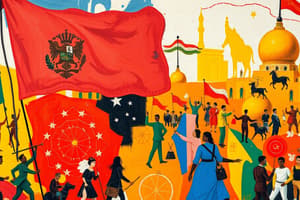Podcast
Questions and Answers
किसने 'स्वराज मेरा जन्मसिद्ध अधिकार है और मैं इसे पाऊंगा!' की मांग की थी?
किसने 'स्वराज मेरा जन्मसिद्ध अधिकार है और मैं इसे पाऊंगा!' की मांग की थी?
- लोकमान्य तिलक
- राम मोहन राय
- बंकिम चंद्र चट्टोपाध्याय
- बाल गंगाधर तिलक (correct)
किसके द्वारा गाया गया गीत 'वंदे मातरम' भारतीय राष्ट्रवाद की एक प्रमुख प्रतीक बन गया?
किसके द्वारा गाया गया गीत 'वंदे मातरम' भारतीय राष्ट्रवाद की एक प्रमुख प्रतीक बन गया?
- लोकमान्य तिलक
- राम मोहन रॉय
- बाल गंगाधर तिलक
- बैंकिम चंद्र चट्टोपाध्याय (correct)
कौन-सा समुदाय समाज में सुधार के प्रोत्साहक के रूप में सम्मानित होता है?
कौन-सा समुदाय समाज में सुधार के प्रोत्साहक के रूप में सम्मानित होता है?
- राम मोहन रॉय (correct)
- स्वामी विवेकानंद
- स्वामी दयानंद
- पंडित मौहररा
किसने स्वतंत्रता के पक्ष में प्रमुख समर्थन प्रस्तुत किया?
किसने स्वतंत्रता के पक्ष में प्रमुख समर्थन प्रस्तुत किया?
'सती' (विधवा हत्या) के समर्थन किसने किया?
'सती' (विधवा हत्या) के समर्थन किसने किया?
गोपाल कृष्ण गोखले किस विचारधारा का प्रतिनिधित्व करते थे?
गोपाल कृष्ण गोखले किस विचारधारा का प्रतिनिधित्व करते थे?
भारतीय राष्ट्रीय कांग्रेस का मुख्य उद्देश्य क्या था?
भारतीय राष्ट्रीय कांग्रेस का मुख्य उद्देश्य क्या था?
स्वदेशी आंदोलन का मुख्य लक्ष्य क्या था?
स्वदेशी आंदोलन का मुख्य लक्ष्य क्या था?
होमरूल मुहिम के नेता कौन थे?
होमरूल मुहिम के नेता कौन थे?
1947 में किसके परिणामस्वरूप, भारत और पाकिस्तान को स्वतंत्रता मिली?
1947 में किसके परिणामस्वरूप, भारत और पाकिस्तान को स्वतंत्रता मिली?
Study Notes
Class 9 History: Chapter 3 – The Rise of Nationalism
In Chapter 3 of your Class 9 history textbook, we delve into the formative period of nationalism in India, a movement that profoundly shaped our nation and its future. To understand this complex phenomenon, let's explore the central ideas, key figures, and pivotal events that fostered the rise of nationalism in colonial India.
Nationalism's Rise
Nationalism—the concept of identifying oneself with, and supporting, a nation—emerged during the British Raj, a period marked by increasing social and political unrest. The philosophers and thinkers of the time drew inspiration from their cultural heritage and sought to forge a common national identity.
Nationalism gained momentum through various organizations and individuals. Two prominent figures were Bal Gangadhar Tilak and Lokmanya Tilak, who advocated for swaraj, or self-rule. Their call for "Swaraj is my birthright and I will have it!" ignited the flames of nationalism.
Key Figures and Ideas
-
Bankim Chandra Chattopadhyay (1838-1894): A renowned Bengali poet and novelist, Bankim wrote the song Vande Mataram ("I bow to thee, mother"), which became a powerful symbol of Indian nationalism.
-
Ram Mohan Roy (1772-1833): A social reformer and pioneer of the Bengal Renaissance, Roy advocated religious tolerance, education, and the abolition of social practices like sati (widow immolation) and child marriage.
-
Gopal Krishna Gokhale (1866-1915): A prominent Indian nationalist, Gokhale believed in evolutionary nationalism, advocating for peaceful reforms within the British system.
-
V.O. Chidambaram Pillai (1872-1936): A leader of the Indian National Congress, Pillai was known for his participation in the Home Rule Movement and his role in the founding of the Indian Home Rule League.
Key Events
-
The Indian National Congress (1885): Founded by Allan Octavian Hume, the Congress, sometimes referred to as the Moderate Movement, aimed to reform the Indian political system within the framework of the British Raj.
-
The Swadeshi Movement (1905): A response to the Partition of Bengal announced by Lord Curzon, the Swadeshi Movement promoted self-reliance and the boycott of British goods in favor of locally produced items.
-
The Home Rule Movement (1915-1916): Led by Annie Besant and Bal Gangadhar Tilak, the Home Rule Movement called for a limited form of independence while the British were engaged in World War I.
-
Non-cooperation Movement (1920-1922): Led by Mahatma Gandhi, the Non-cooperation Movement involved mass civil disobedience, including the boycott of British institutions and the refusal to pay taxes.
-
The Indian Independence Act (1947): Enacted by the British Parliament, the Indian Independence Act granted India and Pakistan their independence from British rule and partitioned the subcontinent into two separate nations.
In Chapter 3 of your Class 9 history textbook, you'll find a wealth of information about the rise of nationalism in India. The story of our struggle for independence is a rich tapestry of ideas, movements, and individuals who, in their own unique ways, contributed to the creation of modern India. is not relevant to this topic as it references ServiceNow, not historical events. and also do not pertain to the rise of nationalism during the British Raj.
Studying That Suits You
Use AI to generate personalized quizzes and flashcards to suit your learning preferences.
Description
Test your knowledge about the formative period of nationalism in India during the British Raj with this quiz based on Chapter 3 of the Class 9 history textbook. Explore key figures, central ideas, and significant events that shaped the nationalist movement in colonial India.




